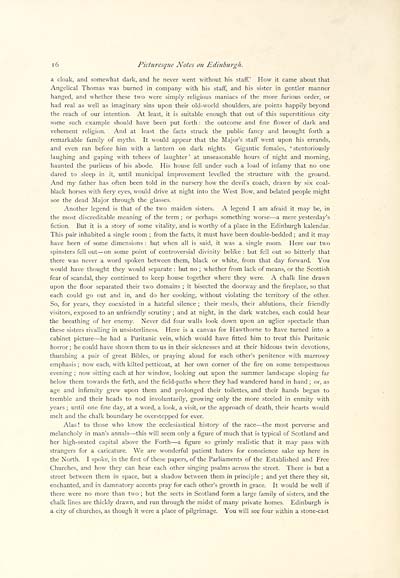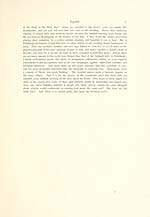Non-Fiction > Books > London, 1879 - Edinburgh
(32) Page 16
Download files
Complete book:
Individual page:
Thumbnail gallery: Grid view | List view

1 6 Picturesque Notes on Edinburgh.
a cloak, and somewhat dark, and he never went without his staff.' How it came about that
Angelical Thomas was burned in company with his staff, and his sister in gentler manner
hanged, and whether these two were simply religious maniacs of the more furious order, or
had real as well as imaginary sins upon their old-world shoulders, are points happily beyond
the reach of our intention. At least, it is suitable enough that out of this superstitious city
some such example should have been put forth : the outcome and fine flower of dark and
vehement religion. And at least the facts struck the public fancy and brought forth a
remarkable family of myths. It would appear that the Major's staff went upon his errands,
and even ran before him with a lantern on dark nights. Gigantic females, ' stentoriously
laughing and gaping with tehees of laughter ' at unseasonable hours of night and morning,
haunted the purlieus of his abode. His house fell under such a load of infamy that no one
dared to sleep in it, until municipal improvement levelled the structure with the ground.
And my father has often been told in the nursery how the devil's coach, drawn by six coal-
black horses with fiery eyes, would drive at night into the West Bow, and belated people might
see the dead Major through the glasses.
Another legend is that of the two maiden sisters. A legend I am afraid it may be, in
the most discreditable meaning of the term ; or perhaps something worse — a mere yesterday's
fiction. But it is a story of some vitality, and is worthy of a place in the Edinburgh kalendar.
This pair inhabited a single room ; from the facts, it must have been double-bedded ; and it may
have been of some dimensions : but when all is said, it was a single room. Here our two
spinsters fell out — on some point of controversial divinity belike : but fell out so bitterly that
there was never a word spoken between them, black or white, from that day forward. You
would have thought they would separate : but no ; whether from lack of means, or the Scottish
fear of scandal, they continued to keep house together where they were. A chalk line drawn
upon the floor separated their two domains ; it bisected the doorway and the fireplace, so that
each could go out and in, and do her cooking, without violating the territory of the other.
So, for years, they coexisted in a hateful silence ; their meals, their ablutions, their friendly
visitors, exposed to an unfriendly scrutiny ; and at night, in the dark watches, each could hear
the breathing of her enemy. Never did four walls look down upon an uglier spectacle than
these sisters rivalling in unsisterliness. Here is a canvas for Hawthorne to have turned into a
cabinet picture — he had a Puritanic vein, which would have fitted him to treat this Puritanic
horror ; he could have shown them to us in their sicknesses and at their hideous twin devotions,
thumbing a pair of great Bibles, or praying aloud for each other's penitence with marrowy
emphasis ; now each, with kilted petticoat, at her own corner of the fire on some tempestuous
evening ; now sitting each at her window, looking out upon the summer landscape sloping far
below them towards the firth, and the field-paths where they had wandered hand in hand ; or, as
age and infirmity grew upon them and prolonged their toilettes, and their hands began to
tremble and their heads to nod involuntarily, growing only the more steeled in enmity with
years ; until one fine day, at a word, a look, a visit, or the approach of death, their hearts would
melt and the chalk boundary be overstepped for ever.
Alas ! to those who know the ecclesiastical history of the race — the most perverse and
melancholy in man's annals — this will seem only a figure of much that is typical of Scotland and
her high-seated capital above the Forth — a figure so grimly realistic that it may pass with
strangers for a caricature. We are wonderful patient haters for conscience sake up here in
the North. I spoke, in the first of these papers, of the Parliaments of the Established and Free
Churches, and how they can hear each other singing psalms across the street. There is but a
street between them in space, but a shadow between them in principle ; and yet there they sit,
enchanted, and in damnatory accents pray for each other's growth in grace. It would be well if
there were no more than two ; but the sects in Scotland form a large family of sisters, and the
chalk lines are thickly drawn, and run through the midst of many private homes. Edinburgh is
a city of churches, as though it were a place of pilgrimage. You will see four within a stone-cast
a cloak, and somewhat dark, and he never went without his staff.' How it came about that
Angelical Thomas was burned in company with his staff, and his sister in gentler manner
hanged, and whether these two were simply religious maniacs of the more furious order, or
had real as well as imaginary sins upon their old-world shoulders, are points happily beyond
the reach of our intention. At least, it is suitable enough that out of this superstitious city
some such example should have been put forth : the outcome and fine flower of dark and
vehement religion. And at least the facts struck the public fancy and brought forth a
remarkable family of myths. It would appear that the Major's staff went upon his errands,
and even ran before him with a lantern on dark nights. Gigantic females, ' stentoriously
laughing and gaping with tehees of laughter ' at unseasonable hours of night and morning,
haunted the purlieus of his abode. His house fell under such a load of infamy that no one
dared to sleep in it, until municipal improvement levelled the structure with the ground.
And my father has often been told in the nursery how the devil's coach, drawn by six coal-
black horses with fiery eyes, would drive at night into the West Bow, and belated people might
see the dead Major through the glasses.
Another legend is that of the two maiden sisters. A legend I am afraid it may be, in
the most discreditable meaning of the term ; or perhaps something worse — a mere yesterday's
fiction. But it is a story of some vitality, and is worthy of a place in the Edinburgh kalendar.
This pair inhabited a single room ; from the facts, it must have been double-bedded ; and it may
have been of some dimensions : but when all is said, it was a single room. Here our two
spinsters fell out — on some point of controversial divinity belike : but fell out so bitterly that
there was never a word spoken between them, black or white, from that day forward. You
would have thought they would separate : but no ; whether from lack of means, or the Scottish
fear of scandal, they continued to keep house together where they were. A chalk line drawn
upon the floor separated their two domains ; it bisected the doorway and the fireplace, so that
each could go out and in, and do her cooking, without violating the territory of the other.
So, for years, they coexisted in a hateful silence ; their meals, their ablutions, their friendly
visitors, exposed to an unfriendly scrutiny ; and at night, in the dark watches, each could hear
the breathing of her enemy. Never did four walls look down upon an uglier spectacle than
these sisters rivalling in unsisterliness. Here is a canvas for Hawthorne to have turned into a
cabinet picture — he had a Puritanic vein, which would have fitted him to treat this Puritanic
horror ; he could have shown them to us in their sicknesses and at their hideous twin devotions,
thumbing a pair of great Bibles, or praying aloud for each other's penitence with marrowy
emphasis ; now each, with kilted petticoat, at her own corner of the fire on some tempestuous
evening ; now sitting each at her window, looking out upon the summer landscape sloping far
below them towards the firth, and the field-paths where they had wandered hand in hand ; or, as
age and infirmity grew upon them and prolonged their toilettes, and their hands began to
tremble and their heads to nod involuntarily, growing only the more steeled in enmity with
years ; until one fine day, at a word, a look, a visit, or the approach of death, their hearts would
melt and the chalk boundary be overstepped for ever.
Alas ! to those who know the ecclesiastical history of the race — the most perverse and
melancholy in man's annals — this will seem only a figure of much that is typical of Scotland and
her high-seated capital above the Forth — a figure so grimly realistic that it may pass with
strangers for a caricature. We are wonderful patient haters for conscience sake up here in
the North. I spoke, in the first of these papers, of the Parliaments of the Established and Free
Churches, and how they can hear each other singing psalms across the street. There is but a
street between them in space, but a shadow between them in principle ; and yet there they sit,
enchanted, and in damnatory accents pray for each other's growth in grace. It would be well if
there were no more than two ; but the sects in Scotland form a large family of sisters, and the
chalk lines are thickly drawn, and run through the midst of many private homes. Edinburgh is
a city of churches, as though it were a place of pilgrimage. You will see four within a stone-cast
Set display mode to: Large image | Transcription
Images and transcriptions on this page, including medium image downloads, may be used under the Creative Commons Attribution 4.0 International Licence unless otherwise stated. ![]()
| Early editions of Robert Louis Stevenson > Non-Fiction > Books > Edinburgh > (32) Page 16 |
|---|
| Permanent URL | https://digital.nls.uk/99396519 |
|---|
| Form / genre: |
Written and printed matter > Books |
|---|---|
| Dates / events: |
1879 [Date published] |
| Places: |
Europe >
United Kingdom >
Scotland >
Edinburgh >
Edinburgh
(inhabited place) [Place depicted] Europe > United Kingdom > England > Greater London > London (inhabited place) [Place published] |
| Subject / content: |
Capital cities Description |
| Person / organisation: |
Bough, Samuel, 1822-1878 [Artist] Seeley Jackson & Halliday [Publisher] Stevenson, Robert Louis, 1850-1894 [Author] Brunet-Debaines, A. (Alfred), 1845- [Etcher] Lockhart, William Ewart, 1846-1900 [Artist] Chalmers, Hector, 1849-1943 [Illustrator] Thomas, R. Kent (Robert Kent), 1816-1884 [Illustrator] |
| Person / organisation: |
Stevenson, Robert Louis, 1850-1894 [Author] |
|---|



